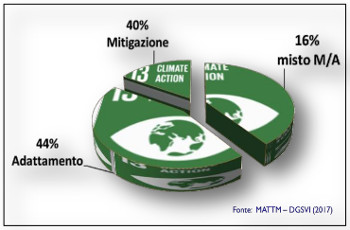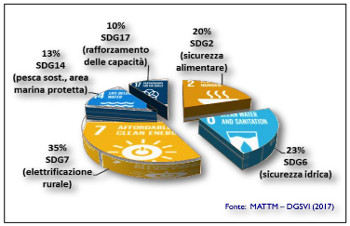Areas of cooperation
The priorities expressed by the PSIDS Governments are largely focused and aimed at building resilient societies, in an effort to address and prevent the risks arising from climate change.
The Cooperation Program has envisaged two macro areas of action that fall within the activities of mitigation, adaptation and contrast of the effects of climate change through the protection of terrestrial and marine ecosystems, paying particular attention, over the years, to small vulnerable communities in rural areas and remote islands.
1) Sustainable Energy (Sustainable Energy Program)
In order to respond to the request for support, from the governments benefiting from PSIDS, to guarantee the diffusion and accessibility of environmentally and economically sustainable energy throughout the country, the main areas of intervention include:
(a) Assessment of energy needs, strengthening of energy policies and action plans
In this context, medium and long-term solutions are needed through actions such as: assessment of technology and energy and infrastructure needs; technical assistance for the development of sustainable technologies; Human Resources Development; collection and analysis of energy data.
(b) Rural electrification
The program aims to increase access to energy mainly through the dissemination and installation of solar systems which represent the most suitable technology for islands where solar energy is the most abundant renewable source. The actions include: use of photovoltaic technology and rehabilitation of existing structures; dissemination of other renewable energy technologies, such as mini hydrological and wind power plants, sized to small-scale realities.
(c) Development of bio-fuels
A variety of locally grown agricultural products, (ethanol from sugar cane, cassava and breadfruit, palm oil), have significant potential for producing bio-fuels for use in local transport and energy. In the light of the potential benefits, but also of the potential criticalities, the program envisaged ex-ante evaluation actions with: assessment of the feasibility of bio-fuel production also taking into consideration the diversification of local sources; pilot projects and tests for the use of bio-fuels; technical studies and process analysis for production sized for small-scale realities.
(d) Development of renewable energy sources
The Pacific region has a variety of renewable sources such as geothermal, hydroelectric, solar, tidal and wind. As with bio-fuels, on the basis of each country's priorities, the program has carried out: feasibility studies and pilot projects to spread photovoltaic energy in urban areas and integrate them into the national electricity grid; wind energy data collection and assessment of existing resources; biogas from household waste; assessment of the potential of geothermal and tides as well as of the energy production by waves; assessment of energy resources by small hydroelectric power plants.
2) Climate Change Adaptation Program (Climate Change Adaptation Program)
Climate change increases vulnerability by acting as an exacerbation factor in the degradation of ecosystems, and as an accelerator for the loss of habitat and therefore of biodiversity. With the SAMOA Pathway, the Governments of all the Small Island Developing States have forcefully reaffirmed their condition of particular natural vulnerability compared to other areas of the world and, while reaffirming their ownership and leadership role in achieving of the sustainable development goals they, nevertheless, underlined the importance and urgency of cooperation as a decisive tool for moving forward.
The activities are divided into two sub-programs which are: (a) disaster risk reduction and (b) protection and conservation of marine and terrestrial ecosystems and biodiversity.
(a) Disaster risk reduction
The climate of the Pacific region is characterized by the thermal instability of the tropical belt, at the origin of the formation of cyclones, to which the ENSO, (El Niño Southern Oscillation), phenomenon and the amplifications due to climate change are periodically added. Within the scenario of the Sendai Framework for Disaster Risk Reduction, which has drawn international attention and commitment to the support necessary for the implementation of measures to reduce the number of people exposed to risk from natural disasters by 2030, the Cooperation Program with the PSIDS provides: the strengthening of early warning systems, (EWS), through the collection, analysis, management and use of relevant data, including the preparation of risk maps, for forecasting the evolution of meteorological phenomena and their impact on society and ecosystems; strengthening disaster risk management and national capacities for disaster prevention, mitigation, preparedness, response, recovery and rehabilitation, and promoting collaboration and partnership between mechanisms and institutions for implementation risk reduction tools; improving the resilience of national health systems; the development of contingency plans for risk management due to natural disasters; the development of adaptation measures for critical installations, such as schools and hospitals; the development of new building codes, rehabilitation and reconstruction practices and standardized building materials; increasing the resilience of new and critical infrastructure, including existing water, sanitation, transportation and telecommunications infrastructure.
(b) Protection and conservation of marine and terrestrial ecosystems and biodiversity
The SAMOA Pathway has recognized that Pacific SIDS have extraordinary marine and terrestrial biodiversity. This is essential for their livelihood and identity, and noted that this precious biodiversity, and the ecosystem services it provides, are also at serious risk due to climate change. Furthermore, the approval of the Sustainable Development Goal 14 of the 2030 Agenda, (conservation and sustainable use of the oceans, seas and marine resources), has given new political impetus to the reduction of marine pollution, sustainable management, protection and restoration of marine and coastal ecosystems, as well as the regulation of oceanic resources. In this context, the sub-program envisages: development of conservation measures for coastal and marine areas affected by the adverse effects of climate change, especially those which are particularly significant for their biodiversity and for the provision of ecosystem services; strengthening of national management and organizational capacity, as well as governance in the fields of protection and conservation of marine biodiversity; development of protected areas; development of programs and projects that improve the resilience of ecosystems and increase the contribution of biodiversity and carbon stocks through conservation and restoration measures; development of measures to minimize and address the impacts of ocean acidification.

The sub-programmes, where possible, will be implemented with the involvement and support of the communities in order to ensure long-term sustainability.
Results obtained in terms of implementation of the 2030 Agenda
Compared to the Sustainable Development Goals of the 2030 Agenda, the priority implemented Goal 13 relating to Climate Action. The projects addressed both the mitigation and adaptation aspects in a homogeneous way and 16% responded to both needs.
At the same time, and by virtue of the interconnections link that exist between all the Sustainable Development Goals, the projects have also made it possible to implement other SDGs.
More than a third of the projects responded to the need for rural electrification by guaranteeing energy security with the replacement of fossil sources with renewable ones.

For about 40%, the activities have made it possible to provide concrete solutions for both food and water security through a better water management, (strengthening water saving capacities and water collection tanks), and the access technologies powered by renewable sources, (water purifiers, sprinklers for agriculture, water pumps for wells).
10% of projects has been focused on training young officials from local governments, in order to strengthen their skills in negotiating and implementing international ocean and climate agreements.
Finally, 13% of the projects had a positive impact on Goal 14, (conservation and sustainable use of the oceans, seas and marine resources), through the establishment of new marine areas and the strengthening of existing ones, but also through the electrification of fishing centers, which has allowed the strengthening of local fishing communities and sustainable small-scale fishing practices.



